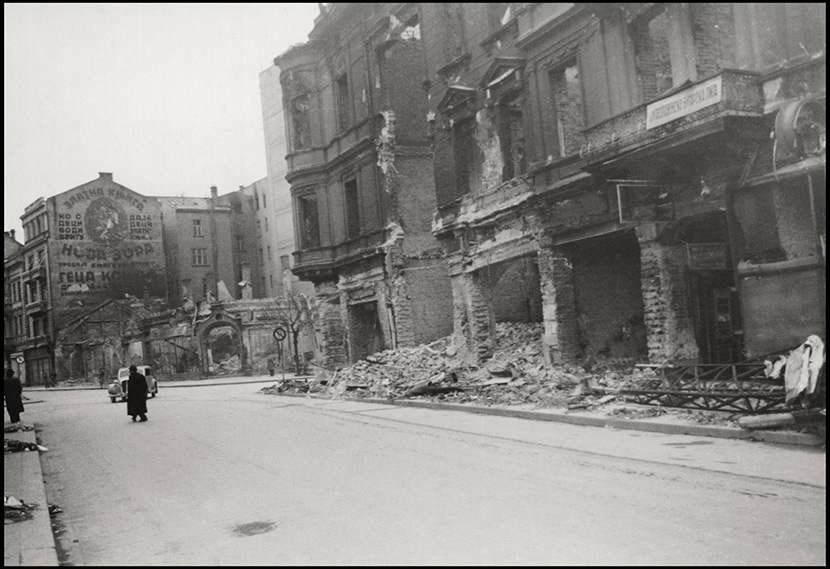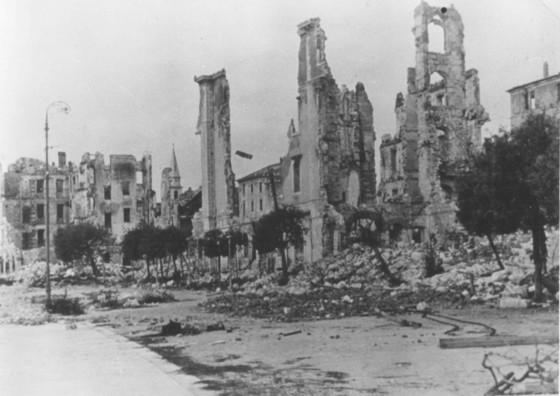Period:
Second World War
Region:
Sumadia
The Allied (American and British) bombing of Belgrade 1944
The bombing of Belgrade in 1944 was conducted by Anglo-American (USA and British) air forces during Second World War, 11 times in total. Infrastructure was bombed three times in April, two times in May, once in June and July, and four times in September.
The greatest casualties were seen during the April bombing, on 16 and 17 April 1944 which was the first and second day of Orthodox Easter that year. The leading unit in this action was the American 15th Aviation Unit which had a base on the south of Italy.
Around 600 bombers were used for carpet bombing from a distance of 3,000-5,000 meters. The air defense system didn’t exist.
The bombing continued more intensively during 17 April, when the concentration camp Sajmište was hit. 60 prisoners were killed on that occasion, and 150 were wounded. Residents of Belgrade believed that bombing was an introduction to the military invasion by the Allies.
Belgrade was struck by the Allies again on 12 April, 24 April, 18 May, 6 June, 8 July, and 3 September 1944.
BACKGROUND
The joint invasion of the Kingdom of Yugoslavia by Nazi Germany, Fascist Italy, and their allies- Bulgaria, Albania, Romania, and Hungary, starting on 6th April 1941, led to its collapse and partition.
The largest part was given to the Independent State of Croatia under the auspices of the Vatican and Nazi regime in Germany. Serbia was occupied and led by the puppet government of Milan Nedic. Immediately with the outbreak of the war, two rebellious movement burst.

Map of invasion on Yugoslav Kingdom in April war, 1941.
At first, chetniks led by general Draza Mihailovic initiated the uprising at Ravna Gora on 13 May, 1941, and two months later, the same did communists. For a short period of time, these two movements had a cooperation, but this ended soon due to the ideological disagreement. They became enemies because communists strived to conduct a socialistic revolution. As the war continued, the communists became concentrated on the west coast of river Drina, while the chetniks were positioned mainly on the east side.
By the end of 1941, Germany was heavily defeated by SSSR in Moscow, and henceforth, the Easter front faced the counterattack and withdrawal of German forces towards Berlin. At the Southern front, AntiHitler coalition successfully started its operations at the beginning of 1943, which led to the breakdown of fascistic Italy in September of the same year.

King Petar II Karadjordjevic in the middle
By the end of November 1943, the meeting was held in Teheran between USSR, Great Britain, and the USA, where the decision was made about giving support to Partisan movement in Yugoslavia. Later, the Yugoslav government in exile was forced to accept this decision in London, since the king Petar II Karadjordjevic was under great pressure.
The initiative came from the Communist leadership that the Allies should bomb cities in Serbia where German forces were positioned, since the liberation of the country was planned for the Summer of 1944 from south.
THE CRIME
Officially declared targets were:
-
The track Belgrade-Sava
-
The airport in Zemun
-
The air plants Rogozarski and Igarus.
Plants Ikarus, Danubijus, Zmaj, Teleoptik, the railway station and the airport in Zemun faced total destruction. The plant Rogozarski and buildings around it, the shipyard, the refinery and the part of the railway station in Belgrade suffered great damage.

Bombing on Ortodox Easter, 1944
During Easter bombing in 1944, the maternity hospital was destroyed which was located in the street of Krunska where the Student’s Hospital is now located. The most heavy destruction was made around the Bajlon open market where 200 people were killed by a bomb. The Albanian Palace (all people died in the shelter), Terazije piazza, the Faculty of Law, and the Faculty of Technical Science, several hospitals, charity organizations, and churches were struck.
“Happy Easter!” was an inscription seen on one of the unexploded bombs
Around 4,000 people died. The results of the bombing were visible on some buildings for seven decades.
AFTERMATH
According to German sources around 1,160 residents of Belgrade were killed, 343 German, and 96 Italian soldiers. Around 5,000 civilians were wounded. Preliminary data which was obtained by the Yugoslav Government in exile, showed that there had been 3,000 victims in Belgrade and 1,200 in Zemun.
The Zemun Archive keeps record of 154 buried people. The Belgrade graveyards have data about 453 buried, unidentified corpses, 104 men, 93 women, and 28 children (668 in total).
THE MATERIAL DAMAGE
After the liberation of Belgrade, the US Embassy made damage evaluation caused by the Allied and German bombing. The total damage caused by bombing was estimated to 220,150,000 dinars ($3,992,000 at the exchange rate from 1939). Of the total amount, damage made to buildings by the American bombing was estimated to 1,222,000, and to property - 1,270,000, while most of the damage made by German bombing was attributed to plunders.
CONTROVERSIES
American headquarter aimed at the beginning of April to destroy a large number of plants, communications, and oil fields in Romania, especially those installations which operated for the main plant Messerschmitt in Wiener Neustadt near Vienna. During March and April 1944, the targets in Hungary and Romania were bombed. Belgrade was an alternative target. However, bad weather conditions above Romania contributed to the decision to choose this alternative.

Furthermore, there are records that prove that the Supreme Headquarters of the Partisan movement, specifically Josip Broz Tito and Koca Popovic, asked allied forces to bomb German targets in Serbia. British reports claimed that the bombing of Belgrade had been conducted at the request of Tito.
MONUMENT
Within the complex of Belgrade Graveyard, the memorial-graveyard was built in 1966 devoted to the victims of the bombing by Allies on Orthodox Easter, 6th April 1941. The designer was an architect Milica Momcilovic.
Fifteen memorial panels were placed on eleven built mounds which remind of ditches where the victims had been initially buried. On separate panels, the names of 313 identified victims and information on 78 unidentified men, 71 women, and 16 children.
Tags:
Please, vote for this article:
Visited: 3797 point
Number of votes: 16
|